 |
Hempstead |
|
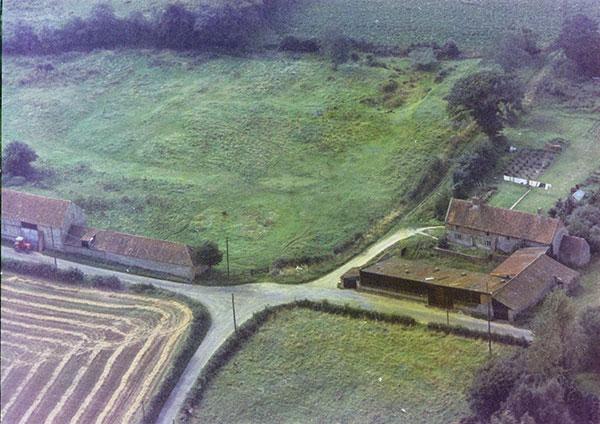 |
Church Farm on the right with its barns on the left - 1971 The outside toilet block can be seen just to the right of the washing line |
| Church Farm House is probably the oldest house in the village. The quality and size of the principal timbers in the two main downstairs rooms suggest a late sixteenth or very early seventeenth-century date. Ian Hinton, Norfolk Historic Buildings Group - 24th August 2021 |
On Friday morning Mr RUMP, farmer at Hempstead, near Holt, was found dead near Oulton, on his way home from North Walsham market. |
Here is what I have put together. Perhaps you may be able to connect my research with yours. I believe that Millsty below is the same lane/path you call Clamp Lane. John Coxton - blacksmith of Hempstead owned 7 acres on north & south side of Millsty, 3 acres on the north & 3 acres on the south and 5 small adjacent parcels, all located in Westfield, Hempstead. Coxton heirs - 1608 sold 7 acres Millsty to Robert Hunt Thomas Brettingham Thomas Brettingham died in 1633 leaving his widow Elizabeth and children Marie, Christopher, Anne, William, John, Katherine, Thomas & Ursula. 1645 Christopher Brettingham, his wife Mary and his mother Elizabeth conveyed Leasehold of 4 acres to brother John (our ancestor) being on the north side of Millsty, divided from the 7 acres. Said property was described as adjoining William King on the West, Christopher Brettingham on the East (possibily being the 4 acres at Puttockhegge) believe this was later the Church Farm House. John Brettingham received the 4 acres in 1645. Both John and his wife Elizabeth died 1654 leaving several sons. 1st born was our ancestor William. Christopher Brettingham held the property as Personal Representative of Elizabeth's estate until his death in 1667. Thomas Brettingham was the brother of our ancestor William Brettingham. In addition to “William's Inheritance,” Elizabeth Brettingham also inherited farmland nearby from her maternal grandfather William Worts. Elizabeth left all to her sister Ursula for her life and then to Ursula's two daughters: Martha Sotherton & Sarah Webber who sold the property (“William's Inheritance” and the Farm) to Robert Britiffe Robert Britiffe died 1749, leaving Church Farm (including the Worts farm & “William's Inheritance”) to his grandson John Hobart, 2nd Earl of Buckinghamshire and son of Robert's daughter Judith. John Hobart, 2nd Earl of Buckinghamshire died in 1793, leaving Church Farm (and accompanying land) to his daughter Caroline Harbord, wife of William Harbord, Lord Suffield. Lord Suffield died in 1821 upon which Caroline Harbord, Lady Suffield took over management of the properties. Some of her parcels of land were west of the village while the majority of the farm was in the east. Her neighbour Richard H. Gurney, Esq. owned much of the farmland to the west. Netherhall is today called Hempstead Hall, but some of his land was also west of the village. In 1828 Lady Suffield and Mr. Gurney joined in a Deed of Exchange in which they exchanged some of their parcels in order to “tidy up” their boundaries. Lady Suffield conveyed 17 small parcels that were located closer to the Gurney property. Though the parcels were not well enough described in the deed to clearly identify, it is likely that one of them was “William's Inheritance”. Richard H. Gurney, Esq. of Hempstead Hall |
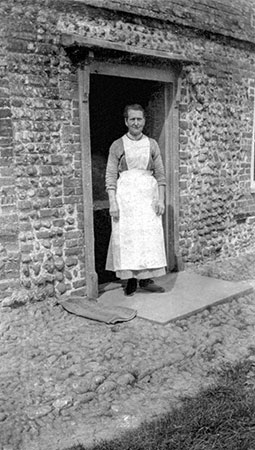 |
Sarah Roy (née Grand 1868-1951) at the entrance of Church Farm c.1929 |
|
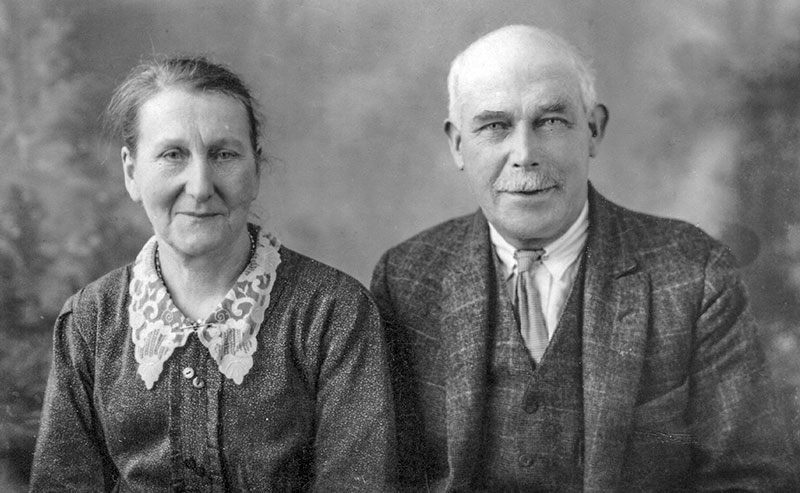 |
Sarah (née Grand) and Alfred Roy after they had left Church Farm house - c.1940 |
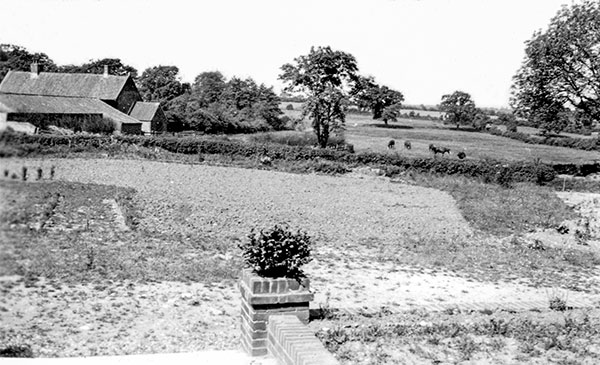 |
North side of Church Farm viewed from Four Elms Cow shed in the foreground with the dairy immediately behind Farm working horses in the field - c.1936 |
One young lad who used to play around the stables at the end of the barn, annoyed the horseman so much that eventually he grabbed the youngster and held him upside down, dragging his hair in the horse wee that was running out of the stable. Apparently, the youngster didn't really seem to mind but his mother was less than impressed when he went home. |
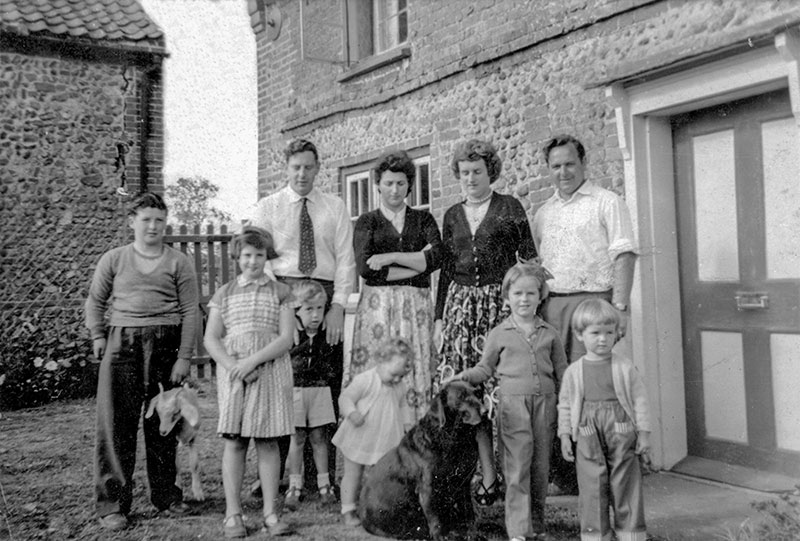 |
Hicks and Lamb families outside Church Farm front door (as was) - 1961
The barn with overhead hay loft on the left was taken down c.1975 left to right - John Hicks, Mary the goat, Ann Hicks, Lionel Hicks holding Paul Hicks, Iris Hicks watching Christine Hicks, Norma Lamb, Pat Lamb, Bess the dog, Jane Lamb, Denise Lamb |
Church Farm and Hole Farm were worked together by different families for some two centuries. |
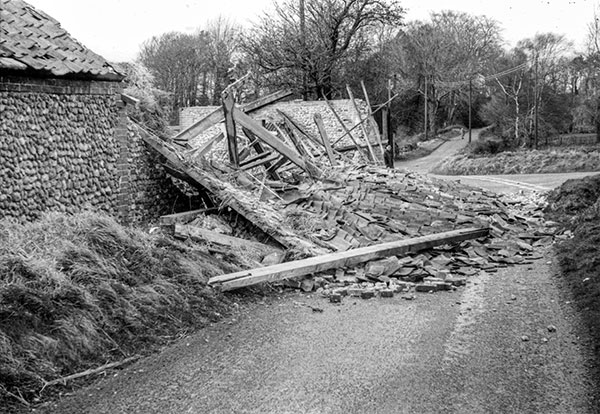 |
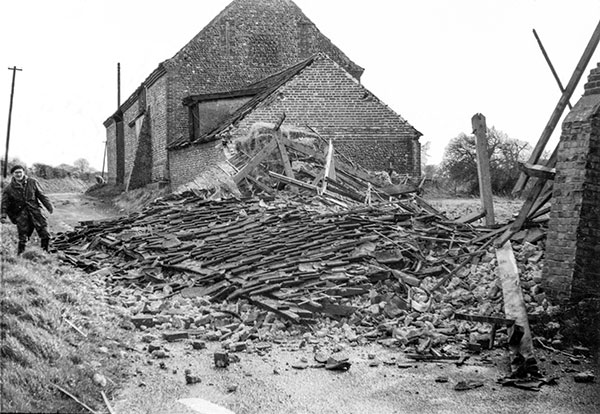 |
Total collapse of the cart shed beside Church Farm barn after a gale looking north c.1972 |
Total collapse of the cart shed beside Church Farm barn after a gale looking south c.1972 |
At one point Church Farm Barn was used as the Village_Hall and some meetings and gatherings were staged there. |
 |
 |
Church Farm barn - c.1980 |
|
Planning permission to convert the barn into a single dwelling was applied for in November 1977 and granted in February 1978. However, it appears that no work was carried out and the planning permission lapsed. A new application was applied for in August 1983 to convert the barn into two dwellings and this was approved in September 1983, with the work being carried out soon after. |
The name Britiffe was earlier recorded in Norfolk as “Brighteve'' in the mid 15th Century. There were a family of that name in Stody, Philip and Jemima who had two children baptised at Stody Church in the 1660s, Charles and Waldergrave. ln 1664 and 1666 one Philip Britiffe paid the highest hearth tax in Hunworth. The Britiffes’ family house was just outside the parish of Hempstead - in the parish of Baconsthorpe. It is now called Pit Farm. The old house is covered with pebble dash' close to the road to the west of the Hare_and_Hounds, Parts of the house are (apparently) unaltered since the Britiffes’ time. All the rooms interconnect, there being no passages. The windows are small. There was a panelled dining room in 1936 but the panelling was later removed. There is a magnificent barn to the south. Robert went to Gresham's School in 1676 being described as “Robert Brightiffe son of Edmund Brightiffe Gent of Baconsthorpe,'' He went on to Caius College, Cambridge. His first wife was Judith (daughter of Henry Edgar of Eye) who died young and is buried at Baconsthorpe Church, leaving him one child only, a daughter also called Judith. Robert was called to the Bar by the Middle Temple in 1682. In NRS 14801 29E1 there is a contract between the two brothers described as then being “of Baconsthorpe'' buying, in 1704, land in Hempstead, adjoining land already owned by them, from William Newman the Lord of the Manor. Robert went into public life becoming both Recorder of Norwich (1704-1730) and MP for Norwich. He became the confidant and lawyer to Sir Robert Walpole (who built up a huge estate at Houghton, owned the finest non royal collection of pictures in the country and started building Houghton Hall in 1721). Robert married off his daughter by his first marriage Judith in 1717 to young Sir John Hobart bringing with her a dowry of £15,000 which it is said together with her share of her father's estate effectively preserved the Blickling estate for her descendants. Sir John's sister, Henrietta, was married to the Earl of Suffolk but flourished more publicly at the Court of George II as mistress of the Prince of Wales where her influence was such that she obtained a peerage for her younger brother John and later an earldom - that of Buckinghamshire. Hole_Farm passed through the female line several times. In the early 18th Century Testators seem to have been quite uninhibited in preferring one daughter to another or even to a son. But equally they required the chosen child to provide financially for its siblings. The papers are to be found at the NRO under Reference MC/184/1/4/1-10 Bundle No. 15. |
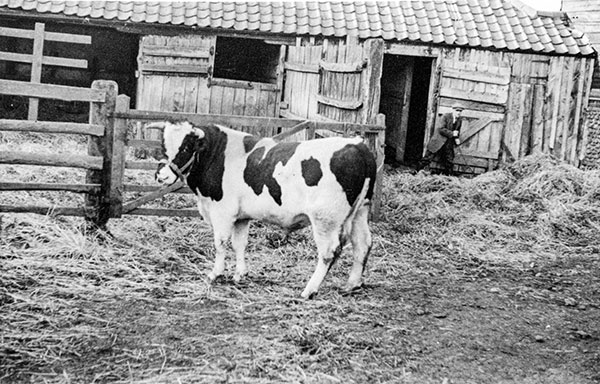 |
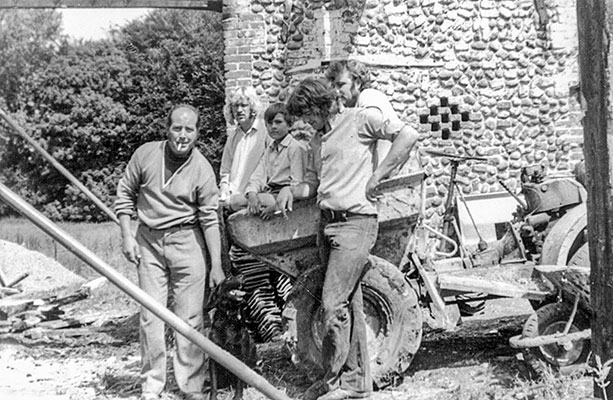 |
Church Farm bullock shed, the former cow shed, where the cows were milked to supply the dairy - c.1950 |
Work on converting Church Farm bullock shed to Church Farm Lodge - 1983 |
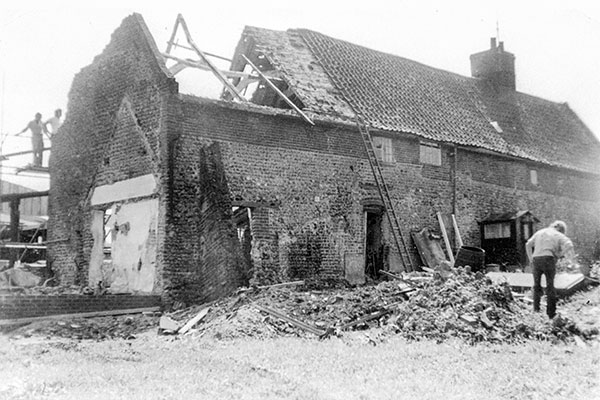 |
Church Farm dairy being converted to become Lynnwood House - 1983 At this time the roof was of Norfolk red pantiles, later to be replaced by concrete tiles |
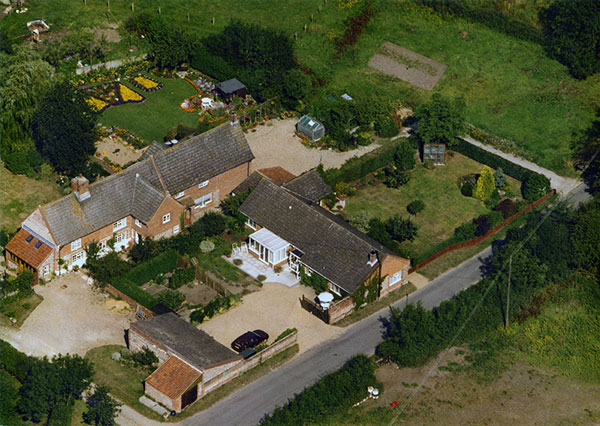 |
20th August 1996 Church Farm - left; Lynnwood House - upper right (old dairy); Church Farm Lodge bungalow (old bullock shed) |
In NRO 14628 29 DI there is a bundle of papers prepared and signed by Mr Benjamin Whitney, who seems to have been Colonel Harbord's Agent at Blickling. Mr Thomas Rump of Church Farm was then tenant of 163 acres. There were 134 acres of arable land and 29 acres of buildings and meadows. The meadows were “of coarse quality''. There were three cottages, each being described as being ''one cottage with two tenements''. Whitney in August 1809 reckoned the whole to be worth £228.pa. '9th August 1809. This farm and the one occupied by this tenants brother to be measured, they both expire at Mich's 1810'. In his description of the Church Farm Cottages, Whitney lists and describes them and their tenants as follows - It seems likely that the three Church Farm cottages each then occupied by two families are the same three double cottages of which two passed to the Youngs family with Pit Farm in 1936 to be sold off the farm in 1970 (that is “Marlpits'' and “Tinkers Cottage”) and one (“Pond Hills Cottages”) which remained with Church Farm which was sold in the eighties by the Carvers. Alternatively they may have been the predecessors of the three surviving “pairs'' (now each one house), with Lady Suffield rebuilding on the same sites over a period of time. This theory is borne out by the 1841 Tithe Map which shows Lady Suffield as owner and the (now) two pairs in Marlpit Lane occupied by William Allen and others. On the map only one half of Marlpit Cottage now owned by Mr & Mrs Durst is shown as then existing, possibly indicating that the rebuilding process was still incomplete. Farming was very profitable in the Napoleonic Wars. The rents charged by Whitney would in real terms exceed those paid by farmers today. It would seem highly likely that the Blickling Estate would have built these cottages out of their high farming rents to enable the Rump tenant to house his workers. The fact that one pair of cottages enjoyed ''large gardens'' ties up with the fact that the pair alongside Church Farm Barns had far larger gardens than their fellows in Marlpit Lane. It was following the death in 1793 of John, the second Earl of Buckinghamshire (and Robert Britiffe’s grandson) without male issue, that Lady Caroline Suffield, the second daughter, inherited the Blickling Estate - the eldest daughter Harriet having married the Sixth Marquis of Lothian. Caroline was married to Colonel Harbord, who later became Lord Suffield, and it was he who then administered the estate until he died in 1821. |
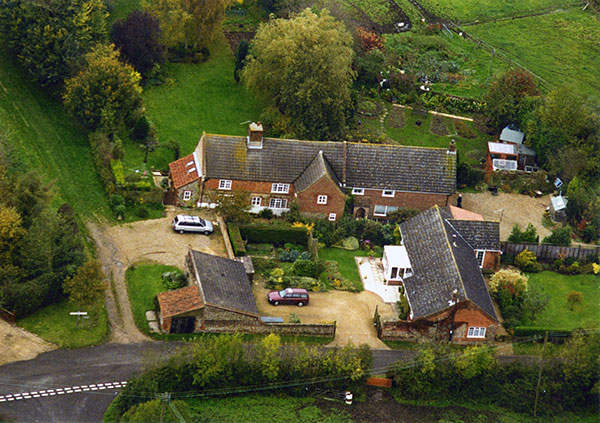 |
26th October 1999 Church Farm - left; Lynwood House - right (old dairy); Church Farm Lodge bungalow (old bullock shed) |
NRO MC3 10/4 is a fine map dated 1805 and prepared by Richard Funnell junior. The heading is: Detached from the main holdings were some meadows and fields adjoining the Glaven above the bridge on the Edgefield to Holt Road. What is now known as Edgefield Old Hall is clearly shown and is numbered 1 on the schedule but is only described as “Houses yards gardens etc”. The map is tantalising for what at omits. It does not show Pond Hills Cottages or the Pond. Instead it leaves the area blank as belonging to “Hon Col Harbord”. It looks as though the map maker was told to ignore Hole_Farm, already in the same ownership. The map maker shows the prominent mound (now afforested) at the joining of the Pond Hills woods and Church Farm's 6 acre field. Even the heading to the map is misleading since the map only shows part of the Colonel's lands (his wife's) in Hempstead. The clue may lie on a note written on the outside of the plan apparently reading “Survey of Yard(?) Farm Edgefield (Col Harbord) 1805”. The total acreage was 263 acres of which 18 was pasture and 39 woods - Pond Hills woods are marked throughout as “Coneygrounds''. lt seems that Lady Suffield, who, following her husband's death in 1821, had taken on the full management of the estate, was particularly interested in its western extremities. It was she who built the first Stody Lodge and other cottages and laid out the Stody Woods in the 1830s, In Hunworth she built Breck Farm, overlooking the Glaven, and the School and the Rectory. Thus she could well have rebuilt the three pairs of estate cottages by Church Farm and in the Marlpit Lane Hempstead. Again it may well have been she who built the great double barn at Church Farm, now converted into two good houses. At the Norwich Record Office (NRS21406) there is a delightful 1824 map of the Pond Hills area by Mr Funnel of Stody. The pond is shown as an exact square (like a medieval fish pond) and the cottage is called “Pond House''. The roadway, passing this house towards the east (and which comes out at the north-east corner of Pond Hills Woods) then went straight across the Hole_Farm field to the corner where the Baconsthorpe road and the Plumstead road part company. All the Hole_Farm land which appears on the map is shown as being owned by Lady Suffield and occupied by ''Mr Johnson”. Also included is a letter dated January 10th 1824 from Mr Funnel to Lady Suffield enclosing the map and telling her what the various letters on the map represented, where she entered the wood, where she met somebody, where she moved onto land occupied by another tenant, etc. It sounds as though this must have been Lady Suffield’s first visit to Pond Hills (coming as it did only three years after her husband's death) because Mr Funnel writes that he will make a “more perfect plan” after “her Ladyship shall have made such alterations and improvements as your ladyship shall think proper”. Lady Suffield is already shown in the 1815 Edgefield Enclosure Award Map as owning adjoining land to the south, and indeed she had owned all this land since the death of her father in 1793, so it does seem odd that she had never previously visited Pond Hills. Running through Pond Hills are some gravelled and well graded roadways with all the appearance of being carriage drives. Adjoining them are many splendid oaks and beeches and a fine Wellingtonia. Oaks grow slowly in Norfolk. Those farming the belt to the south of the Pond Hills were planted at the time of the Crimean War and when one was cut down in the nineties this dating was confirmed by the number of rings. The Pond Hills oaks are appreciably larger than those in the belt and hence it seems more likely that not that they were planted by Lady Suffield in the 1820s and that she was responsible for the carriage drives. It was, after all, the date of the craze for the “Picturesque'' and Humphrey Repton was producing his Red Books of many of the neighbouring estates. |
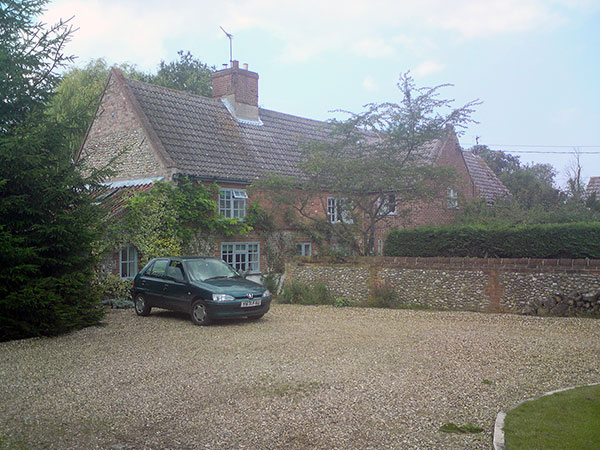 |
9th August 2009 |
One cannot but wonder why Church Farm House together with its pond and fine barn seems to have been built, not at the centre, but towards the north-west corner of its farmland. The likely reason emerges from a contract of exchange (NRS 13479 28 85) dated February 26th 1828 between Lady Suffield and Mr R H Gurney, presumably motivated by a mutual desire to tidy up their boundaries. Lady Suffield agreed to convey to Mr R H Gurney numerous fields in Hempstead, particularly around the Church and Marlpit Lane. In exchange Mr R H Gurney agreed to convey land of his in Baconsthorpe and Stody. An appreciable part of Church Farm was thus conveyed away by Lady Suffield but subject to the lease of Thomas Rump who (see above) eighteen years before, was tenant of 143 acres. Of this farm some 50 acres were to pass to the Gurney estate. This may have made the rest of Church Farm unlettable when the Rump family eventually gave up its tenancies. The 1841 Tithe Map shows 53 acres of Gurney-owned land still farmed by William Rump. |
 |
Marriage certificate of the marriage of Thomas Rumpe and Amy Nash of Plumstead at Hempstead - 13th October 1785 Thomas and Amy were the parents of William Elden Rump b.1809 |
 |
Marriage certificate of the marriage of William Elden Rump to Catherine Hendry (née Leeder) at Wells - 14th July 1864 Catherine had previously been married to Thomas Hendry and her son, also Thomas, later came to help her run the farm |
|
|
|
 |
The history of Church Farm in the latter part of the 19th Century is not very clear but it does seem that (presumably following the death of Mrs Catherine Rump) it came to be farmed directly by the Blickling Estate as an “in hand'' farm. How else can one account for the existence at the NRO (Ref MC3467 515 x 3) of a series of farm accounts, invoices and receipts dated 1883-86 showing that Lady Lothian was farming very actively at ''Hempstead Farm”? Mr W Howes was her foreman and submitted his labour accounts (presumably for reimbursement) fortnightly. The area farmed was 143 acres. ln 1933 in order to raise the Estate Duty payable following the death of the 10th Marquis of Lothian, the Hempstead and Stody Estate was sold to Lord Rothermere, the founder of The Daily Mail. The forced sale of (inter alia) Hole_Farm and Church Farm had an interesting result in that it encouraged the 11th Marquis of Lothian (who was an active Liberal politician) to consider carefully the whole question of the breaking up of old estates, the selling off of historic houses and their valuable contents (the wonderful original library at Blickling having been broken up in a big sale in 1932 to fund the self-same death duties). |
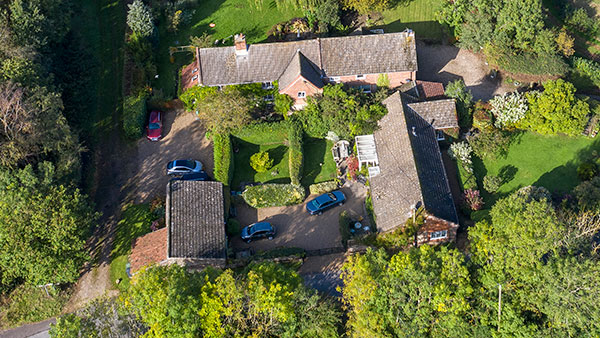 |
9th October 2019 Church Farm House - top left ; Lynwood House - top right (old dairy); Church Farm Lodge bungalow - centre right (old bullock house) |
In notes left by Rev. Auden appears the following: - |
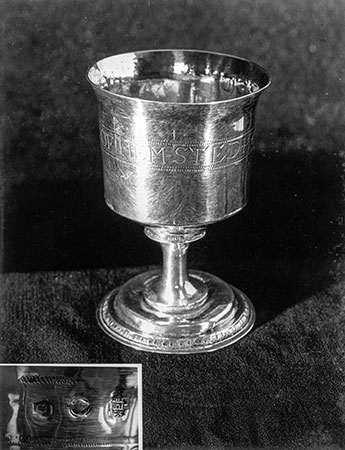 |
Communion Cup FOR THE TOWN OF HEMSTED 1568 |
In 1935 Mr John Hagen died at Hole Farm and his Obituary, headed “Hempstead's Grand Old Man'', was duly published. Through his generosity the large debt on the Village Hall was paid. His last public function was the unveiling of the Jubilee seat in the village on Jubilee Day. Lord Rothermere died in November 1940 and in 1941 Hole_farm and Church Farms with the rest of the Stody Estate were sold to Mr George Knight. Mr Knight died in 1963, learning a large estate coupled with large borrowings so that the farms again had to be sold off to raise the duty and to repay the debt. Mr Knight’s executors sold Pond Hills Cottage but retained the Pond Hills Woods. Pond Hills Cottage was bought by Tessa Moorhouse, a District Judge, who some twenty years later sold it to Adrian Taylor and Yvette Gibson. Tessa Moorhouse had only used the cottage for holidays. The surrounding area had become very overgrown and the dam below the house had fallen into total disrepair. However, in the nineties, Adrian Taylor and Yvette Gibson were able to restore the dam, open up its surrounds, raise the water levels and make a fine garden running down to the water. In 1982 the Carver family bought the two farms. They built a large grainstore and spent the next fifteen years replanting the trees and hedges (but in different positions) that Mr Johnson had removed. The two cottages and the Church Farm Barn on the Pond Hills Road were sold off - the former were converted from two small cottages into one fine house, while the Barn was also very well converted into two substantial houses. |
 |
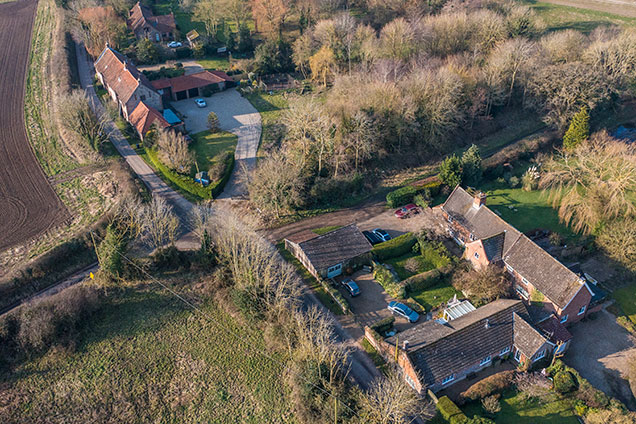 |
1971 |
11th March 2022 |
 |
 |
28th December 2015 |
17th May 2023 |
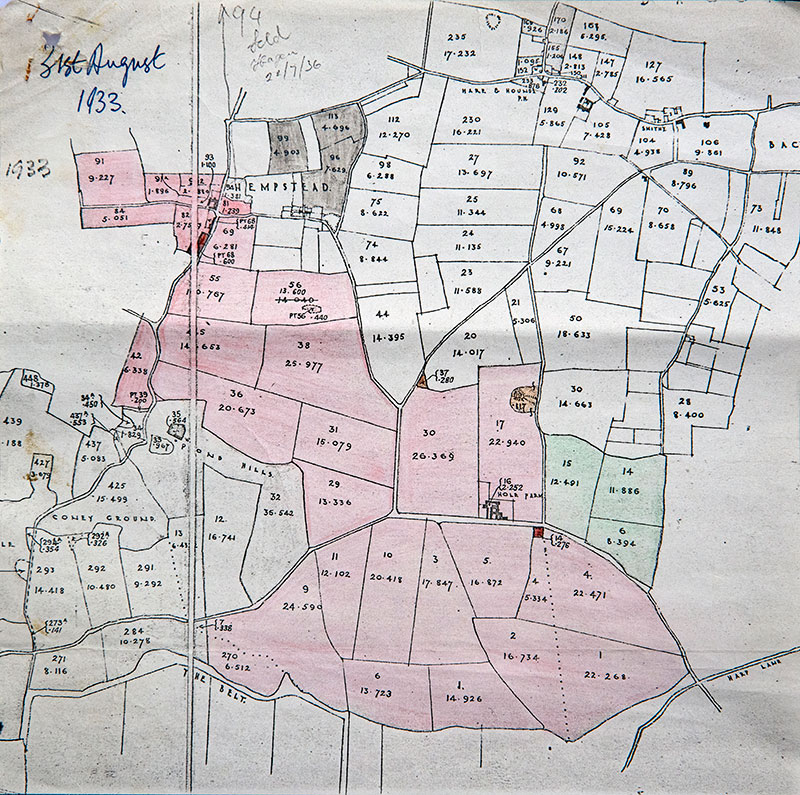 |
Map of Church Farm and Hole Farm combined land showing acreages as sold to Henry Robert Johnson & Litcol Estates Ltd 31st August 1933 |
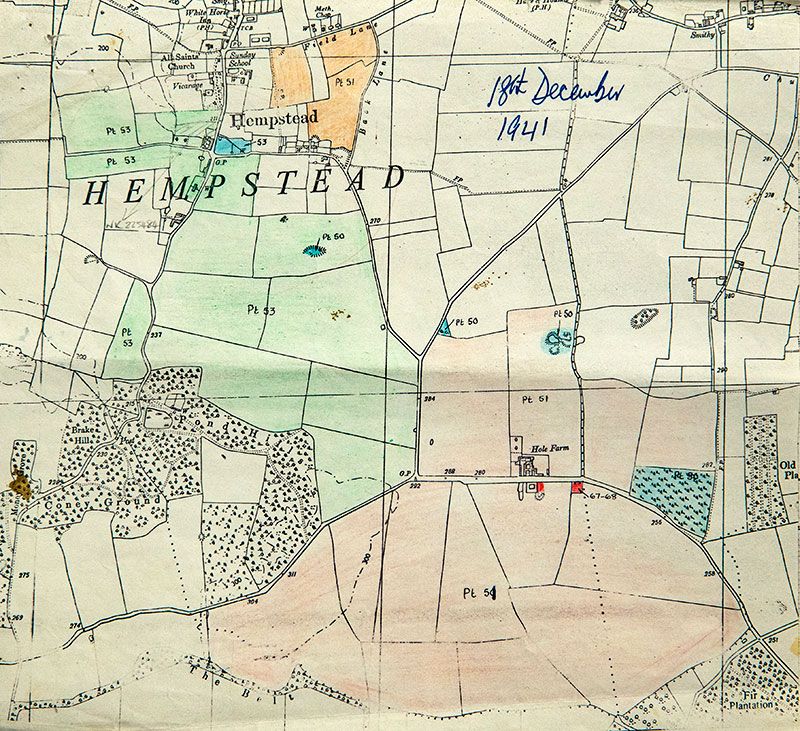 |
Map of Church Farm and its land as sold to Stody Estates Ltd 18th December 1941 |
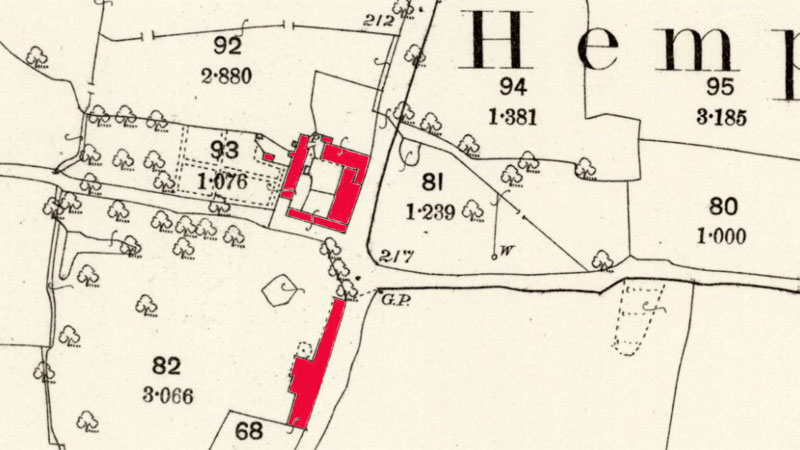 |
O. S. Map 1885 Church Farm house and buildings shown in red Courtesy of NLS map images |
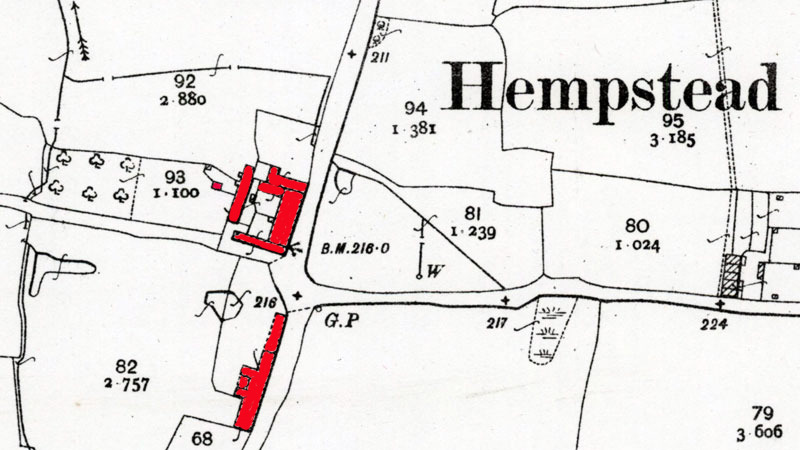 |
O. S. Map 1905 Church Farm house and buildings shown in red Small building to the west of the farmhouse is the double outside privy Courtesy of NLS map images |
| 1825: Thomas Rump, farmer & overseer 27th June 1835: Thomas Rump buried aged 78 (had 12 children) White's 1836: William Rump, farmer
12th Nov 1839: William Elden Rump's daughter, Mary Ann, married Bernard William Bowles at Banningham 4th April 1840: Wilhelmina Maria Ann Rump buried aged 40
27th Sept 1842: William Elden Rump married the widow innkeeper Pleasance Smith (née Fiddy) at Wells White’s 1845: William Elsden Rump, farmer 17th July 1845: Amy Rump (William's mother) buried aged 78 1849: William Rump, farmer & overseer
Kelly's 1858: William E Rump, Farmer
Register of Electors 1861: William Rump, Church Farm Harrods 1863: William Eldon Rump, Farmer, Church Farm 8th April 1863: Pleasance Rump buried aged 62 14th July 1864: William Elden Rump married Catherine Hendry (née Leeder) at Wells White’s 1864: William Elden Rump, farmer 11th November 1866: William Elden Rump buried aged 57
Kelly’s 1879: Catherine Rump (Mrs.) farmer
White’s 1883: Mrs. C. Rump, farmer, Church farm White’s 1890: Rump & Hendry, farmers, Church farm; Rump, Mrs. C. (R. & Hendry)
Kelly’s 1892: Rump & Hendry, farmers Kelly’s 1896: Rump & Hendry, farmers On beam in attic: Sept 19 1898 F. Turner
Kelly's 1925: John Hagen, farmer, The Hole & Church Farms Kelly's 1929: John Hagen, farmer, The Hole & Church Farms Kelly's 1933: John Hagen, farmer, The Hole & Church Farms
Kelly’s 1937: David William Hagen, farmer, Green, Red House & Church farms. Holt 88
Saturday 16th June 1945: George Knight bought the Hempstead Estate from the Gurney family
14th Mar 1972: Plans passed at NNDC re. proposed re-siting of kitchen-bathroom and annexe
17th Aug 2009: Airle Anne Inglis sold to Rosemary Addison Freeguard - Garage area 30th Oct 2009: Rosemary Addison Freeguard sold to Jonathan Neville |
If you have any memories, anecdotes or photos please let us know and we may be able to use them to update the site. Please
or telephone 07836 675369 |
Website copyright © Jonathan Neville 2021 |